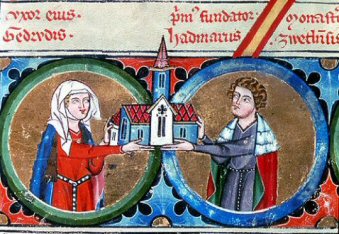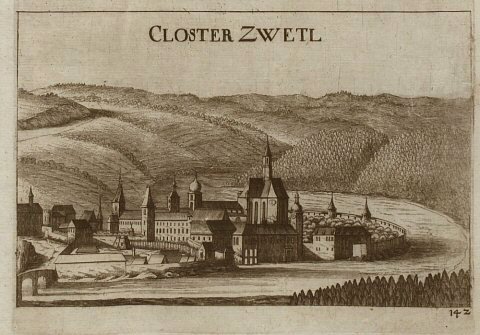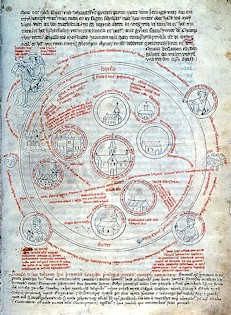In the north-western part of Lower Austria, in a loop of the Kamp, which a few kilometres further becomes the Ottenstein reservoir, lies the Cistercian monastery Zwettl.
The Slavic name Zwettl means "light place, clearing" and - in a broader sense - "light valley", as the name of the Cistercian monastery founded in the 12th century was interpreted in deliberate alignment with the French Cistercian Clairvaux (Latin Clara vallis or Claravallensis).
The year of foundation was 1137, when Emperor Lothar III ruled the empire and Leopold IV of Babenberg ruled the margraviate of Austria, which is part of the Duchy of Bavaria. The Kuenringers had always been faithful ministers, i.e. service providers, for the Babenbergs and had possessions in what is now Lower Austria. The best known are the castles of Aggstein and Dürnstein, where later (1194) the Kuenringer Hadmar II held Richard the Lionheart prisoner.
When Hadmar I of Kuenring founded the Zwettl monastery in 1137 and brought twelve Cistercians with the first abbot Hermann from the mother monastery Heiligenkreuz, the building site was located in the middle of a partly undeveloped forest area, but not far from the old settlement Zwettl and an important highway to Bohemia. The building site for the new Cistercian monastery complied with the order's regulations: it offered seclusion, running water, protection and a rich field of activity for clearing and construction work.

The founders Hadmar I and Gertrud von Kuenring
For the Kuenringers, Zwettl became a burial ground and a house monastery. Hadmar I will probably have experienced the start of construction only in its beginnings or not at all, he died in May 1138. Its foundation was successful: it was founded in 1139 by King Konrad III. (successor of Lothar III.) and 1140 by Pope Innocent II. In 1159 the first church was consecrated.

Zwettl Monastery, copperplate engraving, Georg Matthäus Vischer, 1672
Entrance to the monastery
The Prelate's Court

This wing of the monastery still contains Romanesque elements from the 12th century, the dormitory and the necessarium (latrine facility).
The chapter house is one of the oldest preserved parts of the monastery.
The out jutting latrine house stands directly above a branch of the Kamp - how practical.
The originally Romanesque church building was gradually replaced by a Gothic new building in the middle of the 14th century and finally partially baroque.
The three-nave hall church with the polygonal choir is equipped with huge Gothic windows. The interior is dominated by Baroque furnishings, especially the high altar, but also the pulpit, the richly decorated choir stalls and the choir organ. The main organ, the so-called "Egedacher" organ is one of the largest and most precious organs in Vienna and Lower Austria.
The gothic nave was preceded by a baroque façade with a central tower.

The library hall of the monastery was built by Joseph Munggenast during the baroque period of the monastery complex from the 18th century onwards and was decorated by Paul Troger with colourful ceiling frescos (The Deeds of Hercules).


One of the showpieces in the library archive is the so-called "bear skin" from the early 14th century. This magnificent volume is bound in pigskin, which is popularly known as the skin of a "clean bear", and contains a copy of documents and a summary of the foundation of the monastery.
The gothic cloister resembles that of the mother monastery Heiligenkreuz.
The cloister is an oasis of peace. Readings are held in the glazed part.
The fountain house in the cloister was once the only source of water in the entire monastery.
The Orangery